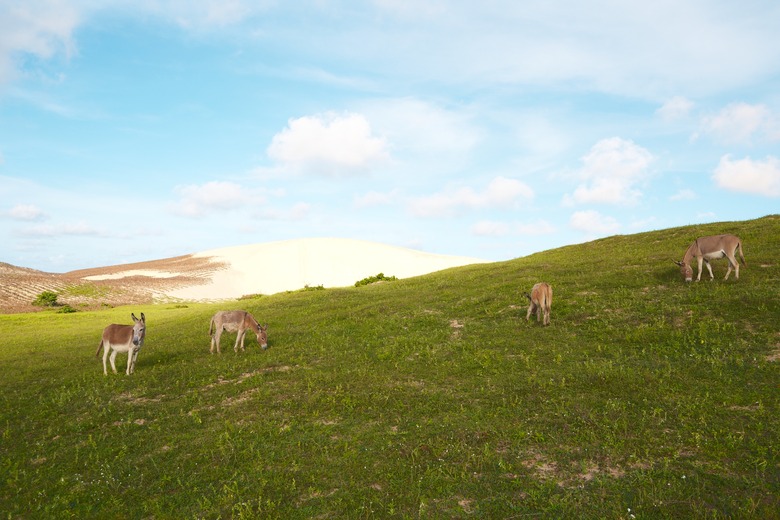Bahia Grass Fertilizer
A warm-season grass, bahia grass (Paspalum notatum) does best when it gets regular applications of nitrogen-rich fertilizer. The two most commonly grown bahia grass varieties are "Pensacola," which grows in U.S. Department of Agriculture plant hardiness zones 7 through 11, and "Argentine," which grows in USDA zones 8 through 11. Bahia grass grows best in neutral to acidic soils in full sun and it's drought-tolerant, so suitable for growing in poor, dry soils. It can be invasive in some areas.
Nitrogen Fertilizers
Regular nitrogen applications promote steady, healthy growth in bahia grass. Bahia grass doesn't form a dense, weed-suppressing lawn, but maintaining healthy growth helps shade out invading lawn weeds. Although it survives without fertilizer applications, bahia grass responds to regular high-nitrogen feeds with vigorous growth. Bahia grass and other warm-season grasses grow through most of the year, becoming dormant only during winter, and fertilizer applications are spread out over the growing season to maintain consistent growth. In colder climates, frost can damage young, soft bahia grass shoots, so it's best to fertilize only between spring and fall. Unlike some other warm-season grasses, bahia grass doesn't form excessive thatch.
Application Rates
Annual fertilizer application rates for bahia grass vary according to USDA zones, growing conditions and the lawn maturity. In USDA zones 10 and 11, bahia grass requires 2 to 4 pounds of nitrogen per year, and in USDA zones 7 through 9 it benefits from 2 to 3 pounds of nitrogen per year. Actual nitrogen is different from the weight of a fertilizer product. The first figure in the set of three in the analysis list — such as 32-0-4 — gives the percentage of nitrogen in the product. To calculate how much of a product supplies 1 pound of nitrogen, divide 1 by the first number and multiply the result by 100. For example, for a 32-0-4 product divide 1 by 32, which gives 0.03125, and multiply by 100, which gives 3.125. Apply 3.125 pounds of a 32-0-4 product to supply 1 pound of actual nitrogen. You can round the final figure up or down slightly to make it easier to measure.
Fertilization Program
Fertilizing bahia grass two to four times a year with a high-nitrogen feed meets its needs. To supply 2 pounds of actual nitrogen yearly, apply a 32-0-4 lawn fertilizer at a rate of 1 1/2 pound per 1,000 square feet every three months in warm zones, or at four regularly spaced intervals between midspring and early fall in colder areas. To supply 4 pounds of total annual nitrogen apply 3 pounds of 32-0-4 fertilizer four times a year, or apply the product according to the manufacturer's guidelines. Water the lawn thoroughly after applying the fertilizer. To avoid over-fertilization, apply no more than 1 pound of total nitrogen per 1,000 square feet at one time. Lawn fertilizers that contain water insoluble nitrogen — listed as WIN on the product label — help reduce polluting runoff.
Iron Supplements
Bahia grass growing in soil with a pH above 7.5 may have problems with iron chlorosis because it cannot access the iron in the soil. You can test your soil pH with a home testing kit or meter. The main symptom is yellow leaf blades. Chelated iron products provide a temporary solution to the problem. Apply an iron supplement containing 5.4 percent chelated iron and 12.8 percent manganese at a rate of 1 pound per 1,000 square feet at the same time as nitrogen fertilizer applications, or apply the product according to the manufacturer's instructions. Alternatively, apply 2 ounces of ferrous sulfate diluted in 3 to 5 gallons of water per 1,000 square feet. Using a fertilizer with ammonium sulfate, ammonium nitrate or urea as your nitrogen fertilizer can help lower the pH in your lawn. Alternatively, replace the grass with another that grows well in soils with a high pH, such as St. Augustine grass, which grows in USDA zones 8 through 10.
References
- University of Florida IFAS Extension: Bahiagrass for Florida Lawns
- Louisiana State University Agricultural Center: Bahiagrass Production and Management
- Virginia Cooperative Extension: Lawn Fertilization For Warm Season Grasses
- Seedland: Calculating Fertilizer Rates & Ratios For Lawn Grass
- Today's Honeowner: How to Correct Soil pH in Your Yard
- Seedland: Soil pH for Lawns & Use of Lime or Sulfur
